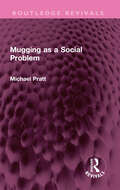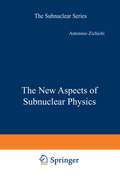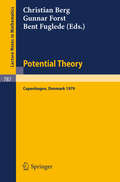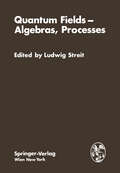- Table View
- List View
Modeling and Differential Equations in Biology
by T. A. BurtonFirst published in 1980. CRC Press is an imprint of Taylor & Francis.
Modelle in der Medizin: Theorie und Praxis 23. Jahrestagung der GMDS Köln, 9.–11. Oktober 1978 (Medizinische Informatik, Biometrie und Epidemiologie #22)
by H. J. Jesdinsky V. WeidtmanMöglichkeiten zur Steuerung des Stoffflusses beim Ziehen großer unregelmäßiger Blechteile (IFU - Berichte aus dem Institut für Umformtechnik der Universität Stuttgart #56)
by V. V. HasekMugging as a Social Problem (Routledge Revivals)
by Michael PrattFirst published in 1980, Mugging as a Social Problem sets out to remedy the deficiency of serious research on mugging. The work is based on a random sample of over 1000 muggings which occurred within the Metropolitan Police District in the mid-1970s, and the author analyses the results not only in absolute and comparative terms but also against a background of social determinants such as ecology, deprivation and race. Dr. Pratt’s long-term solution is not novel: an all-round improvement in housing, employment and social conditions will eventually remove the circumstances which create muggers; but there are steps, he suggests, which can be taken in the short term to stop mugging by reducing opportunity. However, before any effective measures can be introduced, more facts are needed about the background, motives and methods of the typical mugger: it is just such facts that this study sets out to provide. This book will be of interest to students of sociology, law, urban studies and criminology.
Mugging as a Social Problem (Routledge Revivals)
by Michael PrattFirst published in 1980, Mugging as a Social Problem sets out to remedy the deficiency of serious research on mugging. The work is based on a random sample of over 1000 muggings which occurred within the Metropolitan Police District in the mid-1970s, and the author analyses the results not only in absolute and comparative terms but also against a background of social determinants such as ecology, deprivation and race. Dr. Pratt’s long-term solution is not novel: an all-round improvement in housing, employment and social conditions will eventually remove the circumstances which create muggers; but there are steps, he suggests, which can be taken in the short term to stop mugging by reducing opportunity. However, before any effective measures can be introduced, more facts are needed about the background, motives and methods of the typical mugger: it is just such facts that this study sets out to provide. This book will be of interest to students of sociology, law, urban studies and criminology.
Multinomial Probit: The Theory and Its Application to Demand Forecasting (Economic Theory, Econometrics, and Mathematical Economics)
by Carlos DaganzoMultinomial Probit
Multiplicative Number Theory (Graduate Texts in Mathematics #74)
by H. DavenportAlthough it was in print for a short time only, the original edition of Multiplicative Number Theory had a major impact on research and on young mathematicians. By giving a connected account of the large sieve and Bombieri's theorem, Professor Davenport made accessible an important body of new discoveries. With this stimula tion, such great progress was made that our current understanding of these topics extends well beyond what was known in 1966. As the main results can now be proved much more easily. I made the radical decision to rewrite §§23-29 completely for the second edition. In making these alterations I have tried to preserve the tone and spirit of the original. Rather than derive Bombieri's theorem from a zero density estimate tor L timctions, as Davenport did, I have chosen to present Vaughan'S elementary proof of Bombieri's theorem. This approach depends on Vaughan's simplified version of Vinogradov's method for estimating sums over prime numbers (see §24). Vinogradov devised his method in order to estimate the sum LPH e(prx); to maintain the historical perspective I have inserted (in §§25, 26) a discussion of this exponential sum and its application to sums of primes, before turning to the large sieve and Bombieri's theorem. Before Professor Davenport's untimely death in 1969, several mathematicians had suggested small improvements which might be made in Multiplicative Number Theory, should it ever be reprinted.
Multivariate Analysemethoden: Eine anwendungsorientierte Einführung
by W. Schreiner C. Schuchard-Ficher K. Backhaus U. Humme W. Lohrberg W. PlinkeThe New Aspects of Subnuclear Physics (The Subnuclear Series)
by Antonio ZichichiIn August 1978 a group of 80 physicists from 51 laboratories of 15 countries met in Erice to attend the 16th Course of the International School of Subnuclear Physics. The countries represented at the School were: Austria, Denmark, Federal Republic of Germany, Finland, France, Israel, Italy, the Netherlands, Sweden, Switzerland, South Africa, Turkey, the United Kingdom, The United States of America, and Yugoslavia. The School was sponsored by the Italian Ministry of Public Education (MPI) , the Italian Ministry of Scientific and Technological Research (MRSI) , the North Atlantic Treaty Organization (NATO), the Sicilian Regional Government, and the Weizmann Institute of Science. As usual, the Course was devoted to a review of the most out standing problems and results in Subnuclear Physics, with particular emphasis on the new aspects; there were mainly two: supersymmetry and electroweak interactions. In his famous lecture at Erice in 1967, Sid Coleman reviewed "All possible symmetries of the S matrix. " All but one, namely that which tells you: if you have a fermion you must have a boson. This is super symmetry , and this produces the superspace, i. e. an entity which has not only the Einstein-"bosonic" coordinates, but also "fermionic" coordinates. From superspace we get supergravity; and this means that one day we should be able to detect not only the graviton (with spin 2) but also the gravitino (spin 3/2). If we add "flavour", "colour", and "family" as other intrinsic degrees of freedom, we get extended supergravity.
Nonlinear Partial Differential Equations in Engineering and Applied Science: Volume 54 (Lecture Notes in Pure and Applied Mathematics #54)
by Robert L. SternbergIn this volume are twenty-eight papers from the Conference on Nonlinear Partial Differential Equationsin Engineering and Applied Science, sponsored by the Office of Naval Research and held at the Universityof Rhode Island in June, 1979. Included are contributions from an international group of distinguishedmathematicians, scientists, and engineers coming from a wide variety of disciplines and having a commoninterest in the application of mathematics, particularly nonlinear partial differential equations, to realworld problems.The subject matter ranges from almost purely mathematical topics in numerical analysis and bifurcationtheory to a host of practical applications that involve nonlinear partial differential equations, suchas fluid dynamics, nonlinear waves, elasticity, viscoelasticity, hyperelasticity, solitons, metallurgy, shocklessairfoil design, quantum fields, and Darcy's law on flows in porous media.Non/inear Partial Differential Equations in Engineering and Applied Science focuses on a variety oftopics of specialized, contemporary concern to mathematicians, physical and biological scientists, andengineers who work with phenomena that can be described by nonlinear partial differential equations.
Nonlinear Partial Differential Equations in Engineering and Applied Science: Volume 54 (Lecture Notes in Pure and Applied Mathematics #54)
by ROBERT L. STERNBERG, ANTHONY J. KALINOWSKI AND JOHN S. PAPADAKISIn this volume are twenty-eight papers from the Conference on Nonlinear Partial Differential Equationsin Engineering and Applied Science, sponsored by the Office of Naval Research and held at the Universityof Rhode Island in June, 1979. Included are contributions from an international group of distinguishedmathematicians, scientists, and engineers coming from a wide variety of disciplines and having a commoninterest in the application of mathematics, particularly nonlinear partial differential equations, to realworld problems.The subject matter ranges from almost purely mathematical topics in numerical analysis and bifurcationtheory to a host of practical applications that involve nonlinear partial differential equations, suchas fluid dynamics, nonlinear waves, elasticity, viscoelasticity, hyperelasticity, solitons, metallurgy, shocklessairfoil design, quantum fields, and Darcy's law on flows in porous media.Non/inear Partial Differential Equations in Engineering and Applied Science focuses on a variety oftopics of specialized, contemporary concern to mathematicians, physical and biological scientists, andengineers who work with phenomena that can be described by nonlinear partial differential equations.
Numerical Analysis: Proceedings of the 8th Biennial Conference Held at Dundee, Scotland, June 26-29, 1979 (Lecture Notes in Mathematics #773)
by G. A. WatsonNumerische Mathematik: Programme für den TI 59 (Anwendung programmierbarer Taschenrechner #5)
by Jürgen KahmannOnline-Systeme im Finanz- und Rechnungswesen: Anwendergespräch Berlin, 29.–30. April 1980 (Informatik-Fachberichte #28)
by P. StahlknechtOptimal Spatial Interaction and the Gravity Model (Lecture Notes in Economics and Mathematical Systems #173)
by Sven SvenaeusThis book has grown out of a desire to explore the possibilities of using optimizing models in transportation planning. This approach has been followed throughout. Models which combine descriptive and optimizing elements are not treated. The gravity model is here studied as the solution to an optimizing model. In spite of this approach, much of the material shoula be of general interest. Algorithms are not discussed. The author has benefited from discussions with many colleagues. M. Florian suggested the term "interacti vi ty". N. F. Stewart and P. Smeds gave many valu able comments on a first draft. M. Beckmann made me think once more about the final chapters. R. Grubbstrem and K. Jornsten helped clarifYing some things in the same chapters. Remaining insufficiencies are due to the author. Gun Mannervik typed with great patience. Linkoping in October 1979 Sven Erlander ABSTRACT The book proposes extended use of optimizing models in transportation plann ing. An entropy constrained linear program for the trip distribution problem is formulated and shown to have the ordinarJ doubly constrained gravity model as its solution. Entropy is here used as a measure of interactivity, which is constrained to be at a prescribed level. In this way the variation present in the reference trip matrix is preserved. (The properties of entropy as a dispersion measure are shortly discussed. ) The detailed mathematics of the optimal solutions as well as of sensitivity and duality are given.
Ordinary and Partial Differential Equations: Proceedings of the Fifth Conference held at Dundee, Scotland, March 29-31, 1978 (Lecture Notes in Mathematics #827)
by W. N. EverittPeristaltische Strömungen (Medizinische Informatik, Biometrie und Epidemiologie #19)
by Hans J. RathPhysikalisch-chemisches Rechnen mit einer Einführung in die höhere Mathematik
by W. Wittenberger W. FritzDie gesetzliche Einführung der SI-Einheiten bot die will kommene Gelegenheit, das Buch "Rechnen in der Chemie, Zweiter Teil" unter Berücksichtigung der modemen Anschauungen völlig neu zu bearbeiten. Diese Bearbeitung erscheint nun unter dem Titel "Physikalisch-chemisches Rechnen mit einer Einführung in die höhere Mathematik". Das Buch richtet sich an Chemiker im Beruf und an Chemie studenten. Die Erfahrung lehrt, daß zwischen dem Kennen der verschiedenen Gesetzmäßigkeiten der Physikalischen Chemie und deren Anwendung im praktischen Rechnen für den weniger Geübten ein oft mühsamer Weg zurückzulegen ist. Das Hauptgewicht wurde daher auf Beispiele aus der Praxis gelegt und jedes der 257 Beispiele Schritt für Schritt aufgebaut, um dem Benutzer das Einarbeiten zu erleichtern. Ergänzt wird dieses Bestreben durch 387 Übungsauf gaben, deren Lösungen, falls erforderlich mit Hinweisen auf den Rechengang, am Schluß des Buches zusammengestellt sind. Jedem Abschnitt sind theoretische Erläuterungen vorangestellt, wobei betont werden muß, daß das vorliegende Buch nicht ein Lehrbuch der Physikalischen Chemie ersetzen kann und will, viel mehr dieses in der rechnerischen Anwendung ergänzen soll. Der mathematischen Auswertung von Meßergebnissen ist stets ein breiter Raum gewidmet. Für die mathematische Behandlung physikalisch-chemischer Probleme ist die Anwendung der höheren Mathematik unerläßlich. An den Anfang des Buches ist daher eine Einführung in die höhere Mathematik gestellt, die es ermöglichen soll, auf die Zuhilfenahme eines Buches der reinen Mathematik zu verzichten.
Polynomial Representations of GL_n: with an Appendix on Schensted Correspondence and Littelmann Paths (Lecture Notes in Mathematics #830)
by James A. GreenThe new corrected and expanded edition adds a special appendix on Schensted Correspondence and Littelmann Paths. This appendix can be read independently of the rest of the volume and is an account of the Littelmann path model for the case gln. The appendix also offers complete proofs of classical theorems of Schensted and Knuth.
Potential Theory: Proceedings of a Colloquium Held in Copenhagen, May 14-18, 1979 (Lecture Notes in Mathematics #787)
by C. Van Den Berg G. Forst B. FugledeProbabilistic Number Theory II: Central Limit Theorems (Grundlehren der mathematischen Wissenschaften #240)
by P.D.T.A. ElliottIn this volume we study the value distribution of arithmetic functions, allowing unbounded renormalisations. The methods involve a synthesis of Probability and Number Theory; sums of independent infinitesimal random variables playing an important role. A central problem is to decide when an additive arithmetic function fin) admits a renormalisation by real functions a(x) and {3(x) > 0 so that asx ~ 00 the frequencies vx(n;f (n) - a(x) :s;; z {3 (x) ) converge weakly; (see Notation). In contrast to volume one we allow {3(x) to become unbounded with x. In particular, we investigate to what extent one can simulate the behaviour of additive arithmetic functions by that of sums of suit ably defined independent random variables. This fruiful point of view was intro duced in a 1939 paper of Erdos and Kac. We obtain their (now classical) result in Chapter 12. Subsequent methods involve both Fourier analysis on the line, and the appli cation of Dirichlet series. Many additional topics are considered. We mention only: a problem of Hardy and Ramanujan; local properties of additive arithmetic functions; the rate of convergence of certain arithmetic frequencies to the normal law; the arithmetic simulation of all stable laws. As in Volume I the historical background of various results is discussed, forming an integral part of the text. In Chapters 12 and 19 these considerations are quite extensive, and an author often speaks for himself.
Probability Theory on Vector Spaces II: Proceedings, Blazejewko, Poland, September 17-23, 1979 (Lecture Notes in Mathematics #828)
by A WeronQuantum Fields — Algebras, Processes: Proceedings of the Symposium Bielefeld Encounters in Physics and Mathematics II: Quantum Fields, Algebras, Processes with the Workshop White Noise Approach to Quantum Dynamics at the Centre for InterdisciplinaryResearch, Bielefeld University, Federal Republic of Germany, December 19, 1978
by L. StreitAre we living in a golden age? It is now more than half a century that Einstein and Heisenberg have given us the theories of relativity and of quantum mechanics, but the great challenge of 20th century science remains unre solved: to assemble these building blocks into a fundamental theory of matter. And yet, for anyone watching the interplay of mathematics and theoretical physics to-day, developing symbiotically through the stimulus of a lively, even essential interdisciplinary dia logue, this is a time of fascination and great satisfaction. It is also a time of gratitude to those who had the courage to in sist that "a rudimentary knowledge of the Latin and Greek alpha bets" was not enough, and tore down the barriers between the disciplines. On the basis of this groundwork there is now so much progress, and, notably, such strengthening of the dia].ogue with phenomenology that - reaching out for The Great Break through - this may indeed turn out to be the golden age.






















